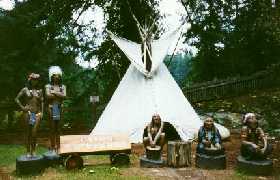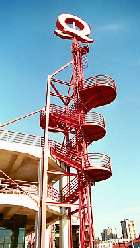Capilano Suspension Bridge is probably Vancouver's oldest attraction, originally built in 1889. Today's bridge is the 4th bridge at this location. It spans 137 meters across and 70 meters above the spectacular, evergreen Capilano River Canyon. The span is said to be wide enough to let two Boeing 747s fly through wing-to-wing with room to spare. This still remains to be proven. The steel cables are connected to a 13-ton concrete block at either end of the bridge: the equivalent, say the site's owner, of four elephants holding onto each side of the cable. Capilano Suspension Bridge and Park was recently named BC's Best Outdoor Attraction for the second year in a row. Every year more than 800.000 visitors come to the site.
Despite the fact that the bridge is swaying under you and that it was raining (we are in Vancouver, eh?), it was not so scaring to cross the canyon. We did see some first-timers clinging to the cables, but they quickly recovered and could manage to stop in the middle to take photos of the canyon.
A "Story Centre" introduces the visitors to the pioneers, who created the history of Capilano and Vancouver, and a lot of information can be gained from the artifacts and the flip-books. First Nations' history is recognized with a native carving centre and a collection of 25 authentic totem poles collected since the 1930's. Trails have been laid out through the 300 year old west coast rain forest, leading along tranquil trout ponds and towering growth. From interactive displays you are able to identify flora and fauna of the forest. Large panels illustrate life in the ponds and the forest. In The Big House you can watch natives carving wood. Finally you can buy tourist stuff like native carvings, leather footwear, books and T shirts in the historic Trading Post.
The next person on the scene is Edward Mahon, who like Mackay arrived in Vancouver in 1888. After years of mining Mahon returned to Vancouver, where he purchased land on the North Shore, among them Capilano Suspension Bridge. 48 years old Mahon fell in love with Lilette, the 19 year old daughter of his deceased friend, James Rebbeck. Mahon asked Lilette's mother, Elizabeth D'abbadie Rebbeck to move into Mackay's cabin and run the place. The plan worked, and one year later Mahon and Lilette married. Elizabeth planted the garden with flowers like rhododendron and azalea. In 1911 a Tea House was built, and in 1914 Mahon reinforced the bridge with additional cables.
The Great War brought hardship and loneliness to Elizabeth, until she met and married a handsome young forest ranger, "Mac" MacEachran. During the depression Mac had to work elsewhere, and for several winters he worked in Tahiti.
In 1953 Rae Mitchell bought the bridge property from Henri Aberneau, who promoted the attraction world wide. In 1956 Mitchell rebuilt the bridge, developed the trails on the west side of the bridge and converted the Tea House into the Trading Post Gift Store. When Mitchell retired, Mitchell's daughter, Nancy Stibbard took over and still operates the business. Nancy Stibbard has renovated the site considerably, and food services, washrooms, information markers, viewing decks and nature trails have all been improved. The Trading Post has been restored to its 1911 condition.
Inside there are 60 fresh market vendors, including daily caught westcoast seafood, daily fresh oven baked treats, hand made confectioneries, soups, fresh pasta, European delis, wine shop etc. etc. Sometimes we can't resist bringing home some special food. Maybe we like the place better because there are not so many tourists as on Granville Island. Birgit likes to check the boutiques with ladies wear. It seems like there are always sales going on.
 One day Janet and Claus took us to Capilano Suspension Bridge and Park, which is located ten minutes from downtown Vancouver - through Stanley Park over Lions Gate Bridge and then north one mile on Capilano Road.
One day Janet and Claus took us to Capilano Suspension Bridge and Park, which is located ten minutes from downtown Vancouver - through Stanley Park over Lions Gate Bridge and then north one mile on Capilano Road. In 1934 Mac told Elizabeth that he had a 19 years old daughter, whom he wanted to bring to Capilano. Devastated by the news Elizabeth agreed, and plans were made to build a new and larger house, Elizabeth died before the house was finished. In 1925 2 Danish carpenters came to Capilano. For food and shelter they carved figures of the native population in red cedar. Unfortunately they only knew Indians from movies and childrens books, so the result were statues of Prairee Indians with war paint and feathers. I'm happy that I took some fotos, because after protest from First Nation People the figures are possibly going to be removed, since the Northwest coastal Indians had very little in common with their relatives from the prairees. But it was quite a surprise to us people coming from Denmark. In 1935 Mac purchased the bridge from Mahon and invited local natives to place their totem poles in the park. In 1945 Mac sold the bridge to Henri Aubeneau and moved to California.
In 1934 Mac told Elizabeth that he had a 19 years old daughter, whom he wanted to bring to Capilano. Devastated by the news Elizabeth agreed, and plans were made to build a new and larger house, Elizabeth died before the house was finished. In 1925 2 Danish carpenters came to Capilano. For food and shelter they carved figures of the native population in red cedar. Unfortunately they only knew Indians from movies and childrens books, so the result were statues of Prairee Indians with war paint and feathers. I'm happy that I took some fotos, because after protest from First Nation People the figures are possibly going to be removed, since the Northwest coastal Indians had very little in common with their relatives from the prairees. But it was quite a surprise to us people coming from Denmark. In 1935 Mac purchased the bridge from Mahon and invited local natives to place their totem poles in the park. In 1945 Mac sold the bridge to Henri Aubeneau and moved to California.
 Almost every time we go to Vancouver Birgit and I take a trip to Lonsdale Quay, which is a huge market place in North Vancouver. Usually we take the Seabus over from the Seabus Terminal in Vancouver. It takes only 15 minutes to cross, and you can use the same ticket as for other public transportation, that is SkyTrain or busses. To be honest we don't go there to buy, althougt there are more than 90 shops in the centre. We go there for the atmosphere, that we like.
Almost every time we go to Vancouver Birgit and I take a trip to Lonsdale Quay, which is a huge market place in North Vancouver. Usually we take the Seabus over from the Seabus Terminal in Vancouver. It takes only 15 minutes to cross, and you can use the same ticket as for other public transportation, that is SkyTrain or busses. To be honest we don't go there to buy, althougt there are more than 90 shops in the centre. We go there for the atmosphere, that we like.
 From the shore of North Vancouver there is a fabulous view of Vancouver's skyline and harbour. We often take a coffee or maybe a cup of soup in one of the outdoor restaurants, enjoying the scenery. Often there is some kind of entertainment, fx an orchestra. Connected to the centre is a tall viewing platform with the giant Q (for Quay).
From the shore of North Vancouver there is a fabulous view of Vancouver's skyline and harbour. We often take a coffee or maybe a cup of soup in one of the outdoor restaurants, enjoying the scenery. Often there is some kind of entertainment, fx an orchestra. Connected to the centre is a tall viewing platform with the giant Q (for Quay).
Come along this way if you will accompany us to beautiful Burnaby, a suburb east of Vancouver. Among other things we are going to visit The Danish Church in Vancouver.